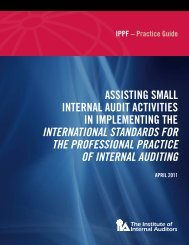2011 State of the Internal Audit Profession Study - PwC
2011 State of the Internal Audit Profession Study - PwC
2011 State of the Internal Audit Profession Study - PwC
You also want an ePaper? Increase the reach of your titles
YUMPU automatically turns print PDFs into web optimized ePapers that Google loves.
As internal audit organizations strive<br />
to transition from financial controls<br />
oversight to advising on a wide range<br />
<strong>of</strong> strategic, business, and compliance<br />
risks, it’s imperative that <strong>the</strong>y<br />
establish credibility with company<br />
leaders by demonstrating <strong>the</strong>ir skills<br />
and capabilities in <strong>the</strong>se areas. If your<br />
internal audit function is not involved<br />
in significant company initiatives, you<br />
should ask why. Is it because your team<br />
lacks <strong>the</strong> required knowledge or skills<br />
to contribute? Or, is it because your<br />
internal audit function hasn’t earned a<br />
seat at <strong>the</strong> table?<br />
As we see it, a need to grow <strong>the</strong> business<br />
in emerging markets, to stay<br />
competitive by adopting innovative<br />
technologies, and to respond to a<br />
rapidly changing regulatory environment<br />
underpin <strong>the</strong> critical risks facing<br />
today’s businesses. If you understand<br />
those risk areas, develop and demonstrate<br />
capabilities to address <strong>the</strong>m, and<br />
<strong>the</strong>n ask for a seat at <strong>the</strong> table, you’ll be<br />
invited as long as you deliver value.<br />
What follows is an analysis <strong>of</strong> how<br />
our <strong>2011</strong> <strong>State</strong> <strong>of</strong> <strong>the</strong> <strong>Internal</strong> <strong>Audit</strong><br />
Pr<strong>of</strong>ession <strong>Study</strong> participants are<br />
preparing for a changed world and<br />
how <strong>the</strong>ir actions compare with what<br />
leading internal audit pr<strong>of</strong>essionals are<br />
doing to meet those same challenges.<br />
New growth, new risks<br />
Only half <strong>the</strong> world is growing at a<br />
robust rate. Although <strong>the</strong> International<br />
Monetary Fund (IMF) forecasts global<br />
growth at 4.2% for <strong>2011</strong>, developed<br />
countries—which make up 52% <strong>of</strong><br />
<strong>the</strong> world economy—are growing at<br />
half that pace. In contrast, emerging<br />
markets are booming, with Indonesia,<br />
India, and China all forecast to grow<br />
faster than 6%.<br />
Ninety-two percent <strong>of</strong> Western<br />
European CEOs expect growth in<br />
<strong>the</strong>ir Asian operations, while only<br />
48% expect growth in <strong>the</strong>ir European<br />
operations. Similarly, CEOs from<br />
Asia-Pacific and Latin America are<br />
more likely to expect growth in <strong>the</strong>ir<br />
own regions than elsewhere. In both<br />
cases, this likely represents a break<br />
from <strong>the</strong> recent past, when increasing<br />
consumption in developed markets was<br />
a primary driver <strong>of</strong> growth. 1<br />
And yet, our <strong>2011</strong> <strong>State</strong> <strong>of</strong> <strong>the</strong> <strong>Internal</strong><br />
<strong>Audit</strong> Pr<strong>of</strong>ession <strong>Study</strong> shows that most<br />
internal audit organizations are only<br />
marginally involved in risks associated<br />
with growth in emerging markets,<br />
cross-border acquisitions, and new<br />
1 14th annual Global CEO Survey, <strong>PwC</strong>,<br />
January <strong>2011</strong><br />
5


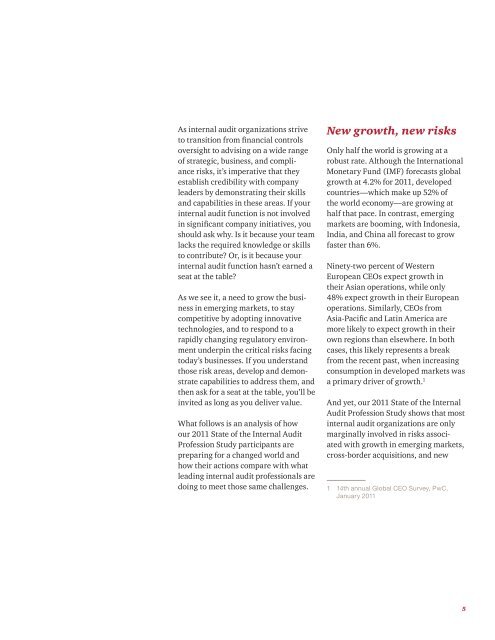
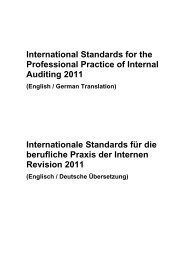

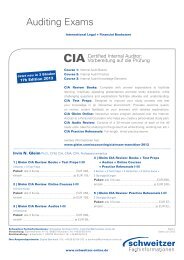
![Ausgabe 02_2011 [PDF, 3.4 MB] - Institut für Interne Revision ...](https://img.yumpu.com/37945857/1/184x260/ausgabe-02-2011-pdf-34-mb-institut-fa-1-4-r-interne-revision-.jpg?quality=85)
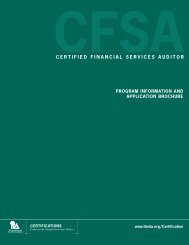
![Ausgabe 2004.2 [PDF, 1.1 MB] - Institut für Interne Revision Ãsterreich](https://img.yumpu.com/37941871/1/184x260/ausgabe-20042-pdf-11-mb-institut-fa-1-4-r-interne-revision-asterreich.jpg?quality=85)
![Ausgabe 02_2009 [PDF, 1.2 MB] - Institut für Interne Revision ...](https://img.yumpu.com/37941824/1/184x260/ausgabe-02-2009-pdf-12-mb-institut-fa-1-4-r-interne-revision-.jpg?quality=85)
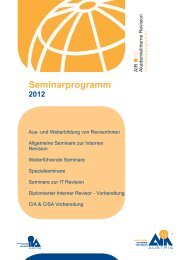
![Ausgabe 03_2011 [PDF, 9.1 MB] - Institut für Interne Revision ...](https://img.yumpu.com/37941423/1/184x260/ausgabe-03-2011-pdf-91-mb-institut-fa-1-4-r-interne-revision-.jpg?quality=85)
![Ausgabe 2006.2 [PDF, 852.7 KB] - Institut für Interne Revision ...](https://img.yumpu.com/37941416/1/184x260/ausgabe-20062-pdf-8527-kb-institut-fa-1-4-r-interne-revision-.jpg?quality=85)
![Ausgabe 03_2007 [PDF, 1.5 MB] - Institut für Interne Revision ...](https://img.yumpu.com/37941405/1/184x260/ausgabe-03-2007-pdf-15-mb-institut-fa-1-4-r-interne-revision-.jpg?quality=85)
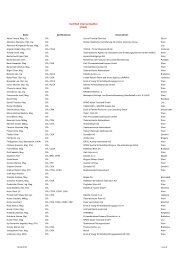
![CEE Konferenzprogramm [PDF, 11.8 MB] - Institut für Interne ...](https://img.yumpu.com/37941387/1/184x260/cee-konferenzprogramm-pdf-118-mb-institut-fa-1-4-r-interne-.jpg?quality=85)
